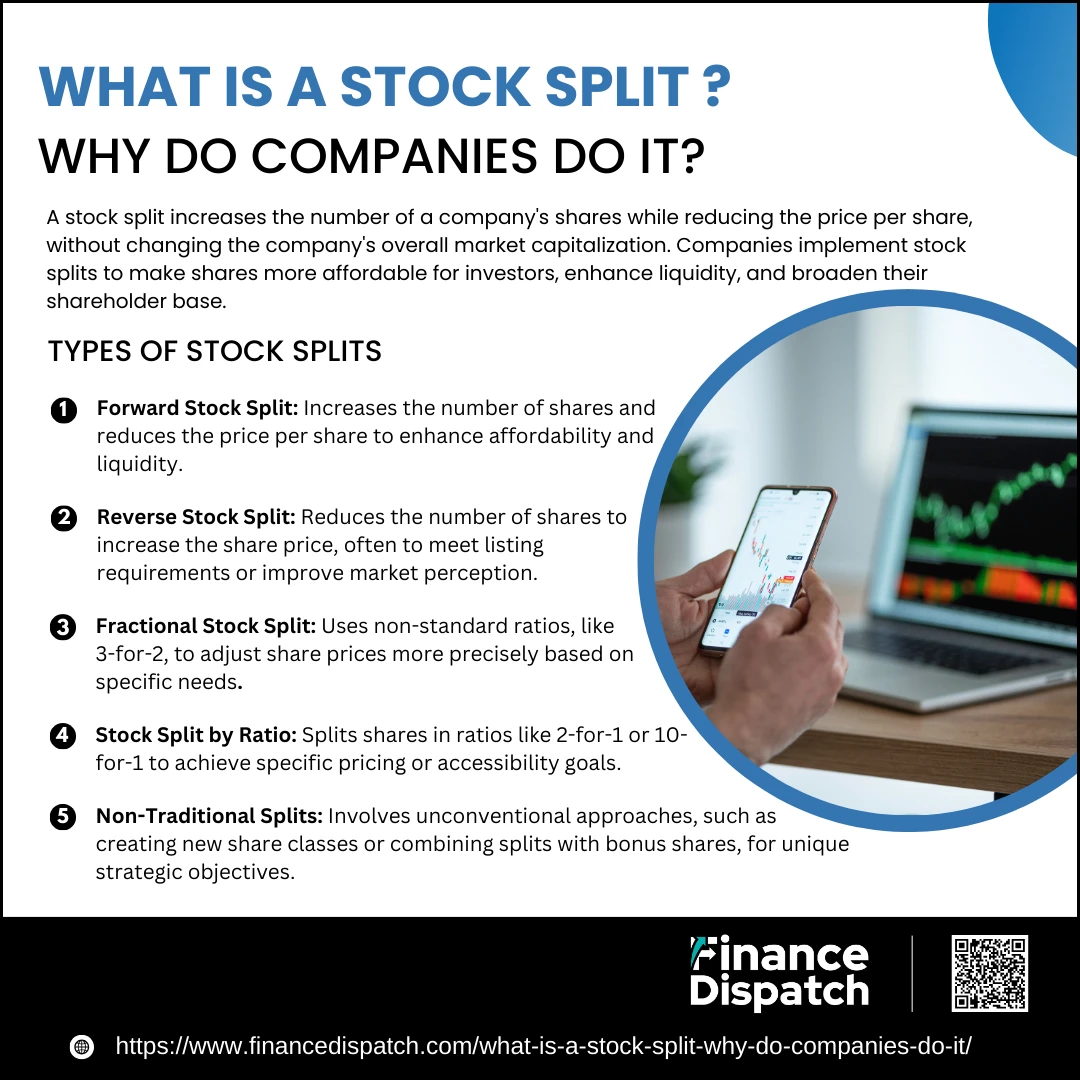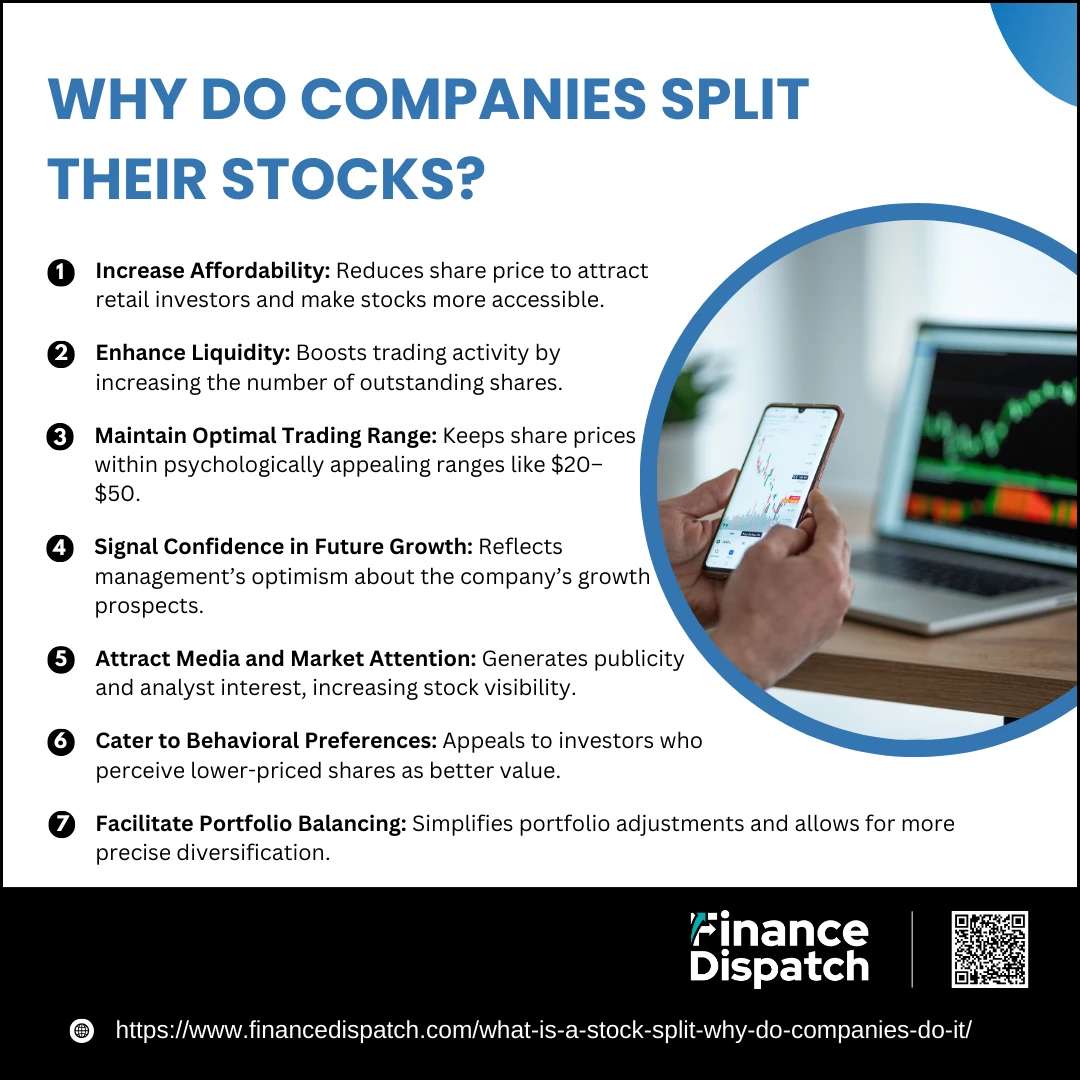Have you ever wondered why a company’s stock price suddenly becomes more affordable without any change in its overall value? This phenomenon often occurs due to a stock split—a strategic move companies make to adjust their stock prices while keeping their market value intact. For instance, when tech giant Nvidia split its stock 10-for-1 after its share price surged past $1,200, it created an opportunity for more investors to participate in its growth story. Stock splits, like this one, are designed to make shares more accessible to everyday investors while maintaining the company’s underlying worth. In this article, we’ll explore what stock splits are, why companies choose to implement them, and how they can impact investors and the broader market.
What is a Stock Split?
A stock split is a corporate action in which a company divides its existing shares into multiple new shares, effectively reducing the price per share without changing the company’s overall market capitalization. It’s like slicing a pizza into more pieces—there are more slices, but the total size of the pizza remains the same. For example, in a 2-for-1 stock split, each shareholder receives an additional share for every one they own, and the share price is halved. This adjustment makes individual shares more affordable, particularly for retail investors, while keeping the total value of the investment unchanged. Stock splits are often used by companies with high share prices to make their stock more accessible and appealing to a broader range of investors.
Types of Stock Splits
Stock splits are an essential tool companies use to manage their stock prices and attract a diverse range of investors. By either increasing or decreasing the number of outstanding shares, stock splits allow companies to adjust their share prices without affecting their overall market value. These splits come in various forms, each serving distinct purposes and having unique implications for investors.
1. Forward Stock Split
This is the most common type of stock split, where the number of shares increases, and the price per share decreases proportionally. For instance, in a 2-for-1 split, shareholders receive an additional share for each one they own, while the share price is halved. This type of split is often employed to make shares more affordable and enhance liquidity.
2. Reverse Stock Split
Unlike forward splits, a reverse stock split reduces the number of outstanding shares by consolidating them into fewer units, thereby increasing the share price. Companies usually resort to reverse splits to comply with stock exchange listing requirements or to improve their perception in the market.
3. Fractional Stock Split
This type of split occurs when companies opt for non-standard ratios, such as 3-for-2. It allows companies to adjust share prices more precisely based on specific needs, offering flexibility in managing stock valuations.
4. Stock Split by Ratio
Companies may perform splits in various ratios, like 2-for-1, 3-for-1, or even more extensive splits like 10-for-1. The choice of ratio depends on the company’s goals, such as making shares accessible or aligning prices with industry peers.
5. Non-Traditional Splits
While rare, some companies choose unconventional split approaches, such as issuing new share classes or combining splits with bonus shares. These are often tailored to meet unique strategic or financial objectives.
Why Do Companies Split Their Stocks?
Stock splits are a deliberate move by companies to adjust their stock prices while keeping their overall market value intact. By dividing existing shares into more affordable units, companies can make their stocks accessible to a wider range of investors, particularly those who may have been priced out before. While stock splits are often seen as cosmetic changes, they can have significant implications for a company’s marketability, liquidity, and investor sentiment. These actions send signals about a company’s confidence and future growth potential while fostering a broader base of shareholders.
1. Increase Affordability
High stock prices can deter retail investors, especially those with smaller portfolios. By lowering the price per share through a split, companies can attract a wider audience, making their stock more attainable for everyday investors.
2. Enhance Liquidity
A split increases the number of outstanding shares, which can boost trading activity. Higher liquidity makes it easier for investors to buy or sell shares at fair market prices, benefiting both individual traders and institutional investors.
3. Maintain Optimal Trading Range
Many companies prefer to keep their stock prices within a specific range, often considered psychologically appealing to investors, such as $20 to $50 per share. Splitting the stock allows them to align prices with these perceived “sweet spots.”
4. Signal Confidence in Future Growth
A stock split can be interpreted as a sign that a company expects its performance to continue improving. By splitting their shares, companies often convey optimism about their financial stability and potential for future growth.
5. Attract Media and Market Attention
The announcement of a stock split can generate media coverage and spark analyst interest, increasing visibility. This attention often boosts investor demand, driving more activity in the stock.
6. Cater to Behavioral Preferences
Many investors perceive lower-priced shares as a better value, even if the fundamental worth of the company remains unchanged. By catering to this psychological tendency, companies can attract more participation in their stock.
7. Facilitate Portfolio Balancing
Lower share prices make it easier for investors to buy fractional shares or adjust their portfolios to achieve a desired allocation without heavily concentrating their investment in one stock.
Key Dates in a Stock Split
Stock splits involve several important dates that shareholders need to understand to make the most of these corporate actions. These dates mark critical milestones in the stock split process, affecting investor eligibility and the trading price of shares. Knowing these dates helps investors stay informed and plan their trading strategies effectively.
1. Announcement Date
This is the day when the company publicly declares its intention to split its stock. The announcement includes key details such as the split ratio, record date, and effective date. It often generates immediate market interest and may influence the stock price.
2. Record Date
The record date determines who is eligible to receive the additional shares resulting from the split. To qualify, investors must own the stock by the record date, as it identifies all shareholders of record.
3. Ex-Split Date
The ex-split date is the first trading day when the stock begins trading at the new, adjusted price. Investors purchasing shares on or after this date will do so at the post-split price and will not receive additional shares from the split.
4. Effective Date (Distribution Date)
On this date, the additional shares resulting from the split are distributed to eligible shareholders. Share prices are adjusted to reflect the new split ratio, and the updated share count appears in brokerage accounts.
Impact of Stock Splits on Investors
Stock splits are a widely used corporate strategy, but their implications for investors go beyond merely adjusting the number of shares and their price. While stock splits don’t change the intrinsic value of a company, they can significantly influence investor behavior, market activity, and portfolio management. Understanding these impacts can help investors make informed decisions and potentially capitalize on the opportunities created by stock splits.
1. Increased Affordability
A stock split reduces the price of individual shares, making them more affordable for retail investors. This can attract smaller investors who previously found the stock too expensive, thereby broadening the shareholder base. For example, a $1,000 stock price reduced to $100 post-split allows more investors to participate.
2. Enhanced Liquidity
With more shares available in the market, stock splits increase trading activity. This higher liquidity benefits both buyers and sellers by enabling smoother transactions and narrowing the bid-ask spread, making it easier to trade shares at fair prices.
3. Psychological Appeal
Investors often perceive lower-priced shares as more accessible and a “better deal,” even though the company’s value hasn’t changed. This cognitive bias can drive demand and create positive momentum in the stock.
4. Portfolio Flexibility
Stock splits offer greater flexibility for portfolio management. Lower share prices enable investors to rebalance their holdings more precisely or allocate smaller amounts of capital to a stock, maintaining their desired diversification without over-concentrating their investments.
5. Short-Term Price Movements
Stock splits frequently generate increased trading volume and short-term price fluctuations. Positive sentiment and the perception of future growth can lead to temporary price spikes, benefiting investors who strategically enter or exit positions during this period.
6. Signaling Effect
A stock split is often interpreted as a sign of management’s confidence in the company’s future performance. This can reassure existing shareholders and attract new ones, reinforcing investor trust and optimism.
7. Tax and Administrative Adjustments
While stock splits don’t result in immediate tax liabilities, they require investors to adjust their cost basis per share for tax purposes. Proper record-keeping is crucial to ensure accurate reporting when shares are eventually sold.
8. Potential Overvaluation Risks
The hype surrounding a stock split can sometimes lead to over-enthusiasm, causing the stock to trade at prices higher than its intrinsic value. Investors should remain cautious and focus on the company’s fundamentals to avoid potential losses when market sentiment stabilizes.
9. Attracting Retail and Institutional Investors
For companies whose stock prices were previously high, stock splits can make the stock appealing to both retail and institutional investors. Retail investors see the lower prices as an opportunity, while institutions benefit from increased trading flexibility and liquidity.
Behavioral and Psychological Effects of Stock Splits
Stock splits, while fundamentally cosmetic, have profound behavioral and psychological effects on investors. One of the most significant is the nominal price illusion, where investors perceive lower-priced shares as more affordable or a better deal, even though the company’s overall value remains unchanged. This perception often drives increased demand for the stock, leading to heightened trading activity and, in some cases, short-term price gains. Additionally, a stock split can act as a confidence signal, where investors interpret the move as management’s optimism about the company’s growth prospects. Cognitive biases such as anchoring—where investors compare the new, lower share price to the pre-split price—and availability bias, driven by the increased media attention surrounding a split, further amplify the stock’s attractiveness. These psychological effects can create a positive feedback loop, increasing the stock’s visibility and market activity, even though the split itself does not alter the company’s intrinsic value. However, these biases can also lead to overvaluation, emphasizing the importance of focusing on the company’s fundamentals rather than the split’s perceived implications.
Examples of Notable Stock Splits
Over the years, several high-profile companies have executed stock splits to make their shares more accessible and appealing to investors. These stock splits often garnered significant attention due to the companies’ market prominence and the strategic nature of their decisions. By analyzing these splits, investors can understand the rationale and potential market impacts of such moves.
| Company | Split Ratio | Year | Pre-Split Price | Post-Split Price | Notable Outcome |
| Apple (AAPL) | 4-for-1 | 2020 | $540 | $135 | Attracted a broader investor base; share price surged post-split. |
| Tesla (TSLA) | 5-for-1 | 2020 | $2,213 | $442.60 | Increased demand led to significant gains in trading volume and stock value. |
| Amazon (AMZN) | 20-for-1 | 2022 | $2,447 | $122 | Made shares more affordable for retail investors; garnered extensive media attention. |
| Nvidia (NVDA) | 4-for-1 | 2021 | $750 | $187.50 | Boosted liquidity and trading activity, signaling confidence in company growth. |
| Alphabet (GOOGL) | 20-for-1 | 2022 | $2,750 | $137.50 | Allowed more retail investors to participate; reinforced management’s growth optimism. |
Reverse Stock Splits: The Red Flag?
A reverse stock split, where a company reduces the number of its outstanding shares while proportionally increasing the price per share, is often viewed as a warning sign. Unlike forward splits, which are associated with growth and accessibility, reverse splits are typically seen as a defensive measure taken by companies facing challenges. They are often used to prevent delisting from stock exchanges due to low share prices or to improve market perception by avoiding the stigma of being a “penny stock.” While a reverse split doesn’t inherently change a company’s market value, it can signal underlying financial distress or a lack of growth prospects. Investors may view it skeptically, associating it with struggling companies, especially if it is not accompanied by improvements in business fundamentals. However, in rare cases, a reverse split can be part of a broader turnaround strategy, helping the company stabilize and rebuild investor confidence. As such, while a reverse stock split is not always a definitive red flag, it often warrants closer scrutiny of the company’s financial health and growth trajectory.
Conclusion
Stock splits are a strategic tool companies use to manage their share prices and attract a broader investor base. While they do not change the intrinsic value of a company, their psychological and practical effects on the market can be significant. Forward splits often signal growth and optimism, making shares more accessible and liquid, while reverse splits are frequently associated with financial struggles or strategic realignment. For investors, understanding the mechanics and implications of stock splits is essential. By focusing on a company’s fundamentals rather than being swayed by the cosmetic nature of a split, investors can make informed decisions and capitalize on opportunities without falling prey to market hype or cognitive biases.






